
94% of researchers rate our articles as excellent or good
Learn more about the work of our research integrity team to safeguard the quality of each article we publish.
Find out more
ORIGINAL RESEARCH article
Front. Mater., 10 August 2022
Sec. Structural Materials
Volume 9 - 2022 | https://doi.org/10.3389/fmats.2022.954525
This article is part of the Research TopicFrontiers in Materials: Rising Stars 2021View all 5 articles
Purpose: The treatment of bone repair has always been a focus of research. In recent years, new metals have been increasingly used for bone repair, and many related studies have been published. However, until now, there has been no bibliometric analysis of these publications. This study uses bibliometrics to evaluate the current research status in this field to predict future research hotspots and development trends and promote the development and progress of this field.
Methods: Global publications on metal materials and bone repair from January 2012 to December 2021 were extracted from the Web of Science database. Microsoft Excel 2016, GraphPad Prism 8, VOSviewer, and CiteSpace were employed to perform the bibliometric study and data visualization.
Results: China contributed the most publications and had the most citations and H-index, especially in the last five years. The journal Materials Science and Engineering C-Materials for Biological Applications published the most papers. The Chinese Academy of Sciences had the most publications among all institutions. The top 10 articles by citations mainly focused on porous polymer scaffolds and the metals zinc and magnesium.
Conclusion: We predict that the total number of global publications will grow in the future according to the relative research interest. Importantly, the current research focus has shifted from metal materials to osteogenic mechanisms. Porous scaffolds, degradation rate, tissue engineering, angiogenesis, and stem cells could be research hotspots in the future.
Bone trauma is an unavoidable disease of human beings. The disease has a 5%–10% incidence of poor healing. Bone defect is a kind of bone nonunion and one of the most serious complications in fracture treatment (Einhorn and Gerstenfeld, 2015). In the current social environment, large-segment bone defects caused by osteomyelitis, infectious nonunion debridement, bone tumor resection, congenital deformities, and severe open comminuted fractures are very common (Hadjiargyrou and O'Keefe, 2014). Despite the strong regeneration ability of bone tissue, large-segment bone defects are difficult to heal by only the patient’s own repair ability (Einhorn, 1995).
The research in this field focuses on the surgical procedures of bone grafting, such as bone transport, the Masquelet technique, autologous bone, artificial bone, and allograft (Horowitz et al., 2014). However, the outcomes of implantation and repair relying only on bone-like frames are not ideal, which is also the reason why there has been no breakthrough in the treatment of bone defects in the past 30 years. Therefore, scholars have not only continued related research in the fields of medicine and biology but also performed related research in the fields of acoustics (Shimizu et al., 2021), optics (Bai et al., 2021), heat (Shu and Sugita, 2020), and others.
Metals are essential trace elements in the human body. They have played an important role in the treatment of bone defects in recent years and have received much attention. In addition to the supporting role of metal materials, the regulation of trace metal elements in the process of osteogenesis has attracted extensive attention, such as the antibacterial effect of Ag (Kumar et al., 2019), the stimulation of cell growth and proliferation by Mg (Zhang et al., 2016), and the recruitment of mesenchymal stem cells by Ca (Fischer et al., 2018). In recent years, studies have concentrated on special metal elements, such as Se, which was not used in osteogenesis in the past because of its highly toxic properties. With the development of sustained-release materials, Se has shown promise with its strong antioxidant effect, which provides strong protection to preosteoblasts under the condition of iron overload (Li et al., 2019). Sr and Zn, which had not received much attention before, also play very important roles in the repair of bone defects. In recent years, their strong osteogenic ability and synergistic effect on reducing toxicity have received particular attention (Venkataraman et al., 2010). These latest advances in the field have led to a new wave of research on metal materials and bone repair.
Bibliometrics is a method to scientifically evaluate the research status of a field and predict future research trends. Through visual analysis of the titles, authors, countries, keywords, and journal information of selected articles, the contribution of individuals and groups in a research field can be objectively evaluated. For example, keywords with high frequency in recent years were identified as research hotspots through comprehensive analysis of keywords in the included articles to provide supporting evidence for predicted future research trends (Agarwal et al., 2016; Roldan-Valadez et al., 2019).
There is no comprehensive bibliometric analysis of the research on metal materials in the context of bone issues, and there is an urgent need for such an analysis. To fill this gap, this study, based on articles published on the Web of Science (WOS), summarized the progress in the research on metal materials in bone repair using the bibliometric analysis method. The core research content in the field of metal materials and bone repair was analyzed, and future research directions and hotspots were identified.
The Thomson Reuters’ WOS database is a large comprehensive database covering the latest research developments and discoveries in various fields and especially in medicine-related fields. The search was performed on a single day, namely March 3, 2022, to avoid complications arising due to the daily update of the database, which may have led to changes in the included studies. The following keywords were used to retrieve all relevant studies: TS = ((bone regeneration OR bone repair OR bone reconstruction OR bone tissue repair) AND (metal material OR metal materials OR metal OR metallic material)) AND language = (English). Because of searching only by search terms is inaccuracy, and articles whose content was inconsistent with our research direction will also be included in our study, so manual screening is necessary, and this will result in a large number of articles that will not be included in our research.
All studies in the database about metal materials and bone repair published from 2012 to 2021 were obtained. Only original articles were included, and those that were irrelevant to the topic were filtered manually. The strategy of manual retrieval requires the overall evaluation of the research content of the article, rather than just looking at the keywords. We make the initial judgment through the abstract, and then make the second judgment through the full text if there is any doubt. Detailed information regarding enrolment and selection is shown in Figure 1. 2,477 literatures related to the research topic were retrieved by the retrieval formula. 2,395 remained after qualifying the type of literature and qualifying the English language, leaving 556 after finally passing the manual screening.
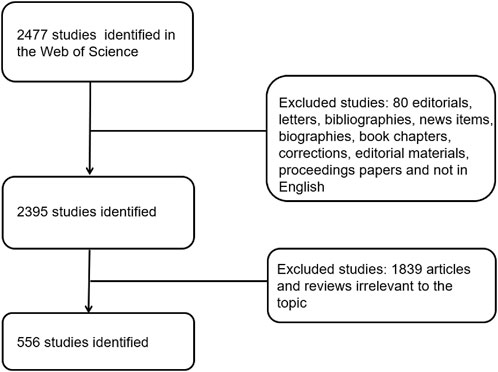
FIGURE 1. Flow diagram of the inclusion process. The detailed process of screening and enrolment is shown. Irrelevant articles were manually screened by two authors through their abstracts and full texts, and articles irrelevant to the topic were excluded.
All data (titles, keywords, authors, countries and regions of origin, institutions, published journals, publication dates, H-index, and sum of citations) were extracted from the identified publications by author (XZR). GraphPad Prism 8, Microsoft Excel 2016, VOSviewer version 1.6.12, CiteSpace version 5.6. R5 64 bit, and an online analysis platform (http://bibliometric.com/) were used for presenting, analyzing, and describing the data.
The H-index is a useful metric for assessing scientific achievements. This value indicates that an author has published at least H papers, and each paper has been cited in other publications at least H times. The relative research interest (RRI) was defined as the number of publications in a particular research field divided by the total number of publications across all fields per year. In our study, the research field was metal materials and bone repair. The impact factor (IF) was obtained from the Journal Citation Reports published in 2021. All these factors had an important contribution to the evaluation of article quality and therefore were used as key indicators for article evaluation.
VOSviewer, which is a science mapping software tool for constructing and viewing bibliometric maps of countries, journals, and keywords based on co-citation data, was used to analyze different aspects of this study. A Java application, CiteSpace, was used to examine and visualize co-citation networks to identify emerging trends, research hotspots, and future research directions through keyword clustering.
A total of 556 articles (23 non-English articles were excluded; 57 articles were excluded because they did not meet the type requirements; and 1,839 articles were excluded because they were not related to the topic) published from 2012 to 2021 met the inclusion criteria. This study focused on six aspects: contributions of countries, contributions of different journals, contributions of different institutions, top 10 articles, keywords, and related fields (Figure 2).
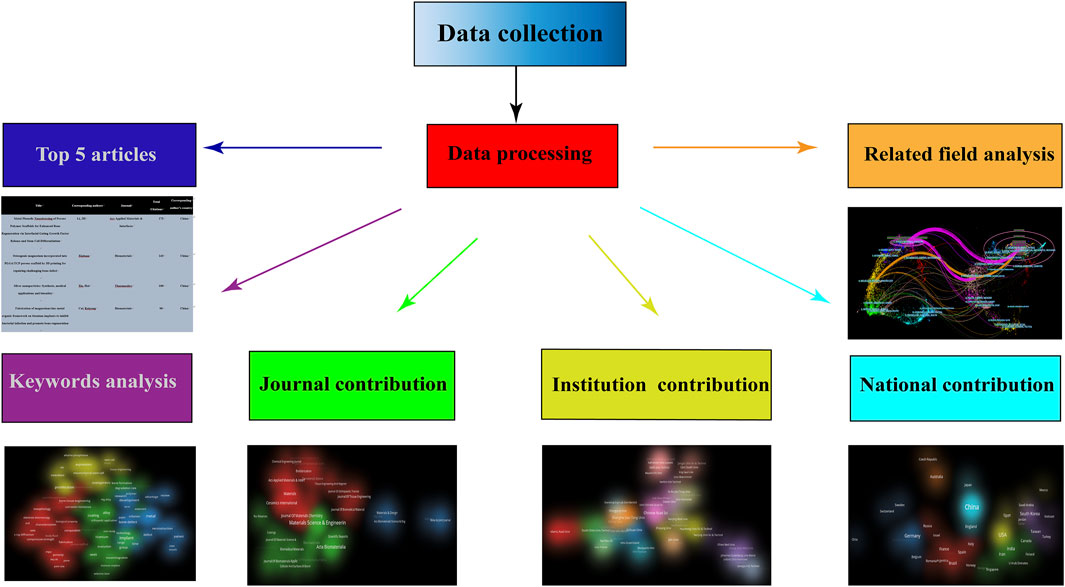
FIGURE 2. Flow diagram of the six studied aspects of metal materials and bone repair: contributions of countries, contributions of different journals, contributions of different institutions, the top 10 articles, keywords, and related fields.
China ranked first (210) in the number of publications between 2012 and 2021, followed by the United States 92) and Germany 47) (Figure 3A). The sum of citations (5,711) and the H-index 19) of China also ranked first. The number of publications in the United States was only one-fourth of that in China, but the total number of citations was roughly similar to that in China (4,513), which reflects the high quality of publications in the United States. Among the top 10 countries in terms of number of publications, Asian and European countries each occupied four spots. Regional aggregation was also a major feature of research in this field. However, when all-field publications were considered, the global interest in the role of metal materials and bone repair by RRI was observed to have steadily increased since 2012 and peaked in 2020 (Figure 3B). China has played a substantial role in this growth trend. The number of publications in China showed a rapid annual increase, especially from 2019 to 2021.
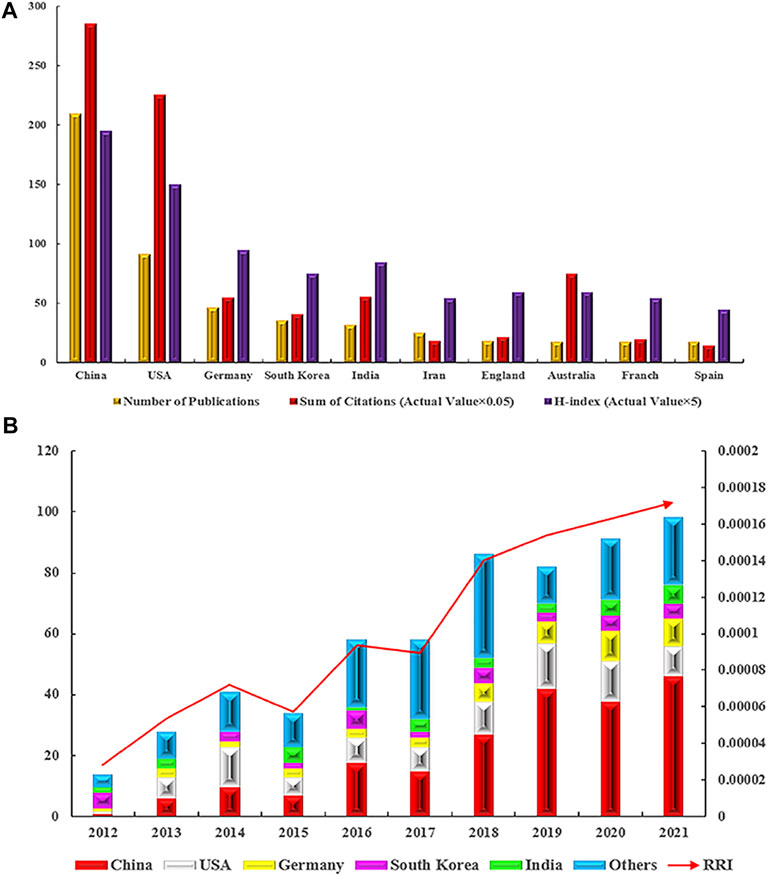
FIGURE 3. Contributions of different countries/regions to the research on metal materials and bone repair. (A) Number of publications, citation frequency (×0.05), and H-index (×5) in the top 10 countries or regions (B) number of publications worldwide and the time course of the RRI in metal materials and bone repair.
The number of publications from different countries is shown in Figure 4A,B. The bigger the circle, the higher the number of publications. In Figure 4B, the color of the circle represents the time when the publication was published as a whole. Generally, the lighter the color, the higher the proportion of the latest publications. As can be seen, the color of the region representing China is the lightest, suggesting that China has contributed highly in recent years. Similarly, the research in this field in Iran and Italy has also gradually increased in recent years. The cooperation between different countries was also visualized. The lines between the sectors represent the degree of cooperation between countries. China, the United States, and Germany all contributed highly in terms of publications, and they also had relatively closer ties to other nations (Figure 4D).

FIGURE 4. Cooperation network of countries/regions regarding research on metal materials and bone repair. (A,B) Network of cooperative relations between countries/regions established by VOSviewer (C) visualized cooperative relations between countries/regions.
The Chinese Academy of Sciences in China ranked first in the number of publications with 35 records (6.227%), followed by Shanghai Jiao Tong University in China with 26 records (4.579%). The Institute of Metal Research Cas in China ranked third with 11 records (2.564%). Chinese investment in basic science has contributed to the rise of the research in this field, as evidenced by these Chinese institutions taking up eight positions in the top 10 list, and notably all of the top five. The other two positions were taken by France and Egypt. This finding shows that Chinese institutions have led the advancement of related science in recent years (Figure 5A).
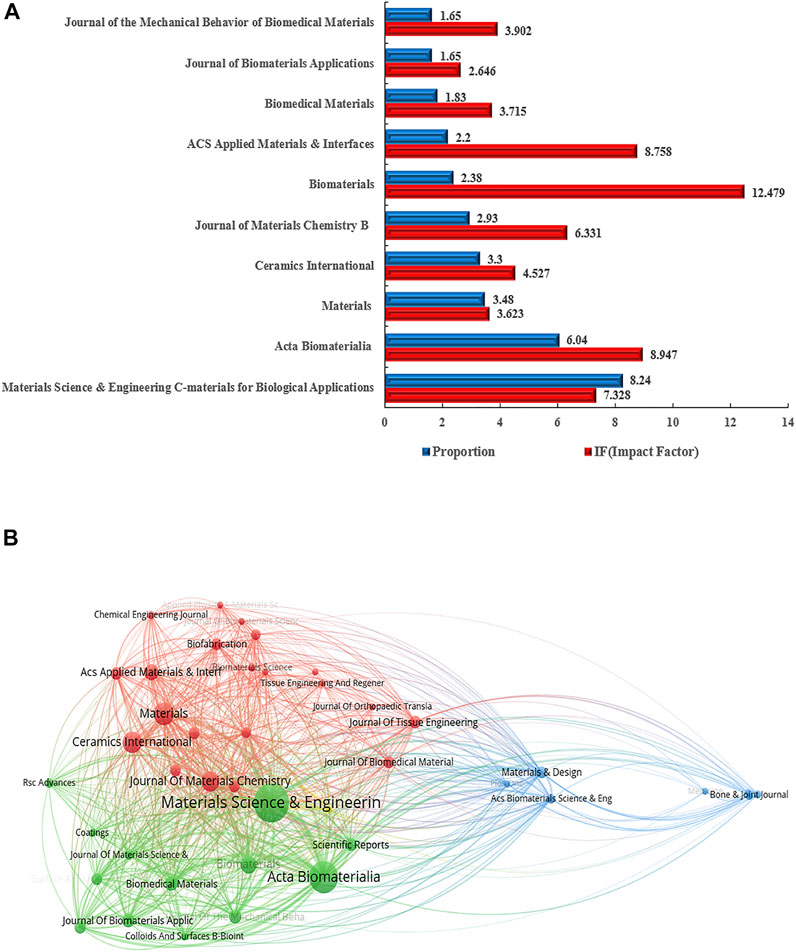
FIGURE 5. Distribution of institutions engaged in research on metal materials and bone repair. (A) Top 10 institutions by number of publications. The numbers represent the percentage of publications, and different colors represent different countries. (B) Network of institutions visualized in VOSviewer. The size of circles represents the number of publications.
VOS viewer was used to visualize the cooperation between institutions worldwide. A large circle indicates a high number of publications, and the lines between the circles represent the relationships between institutions (Figure 5B). The institution with the most publications was the Chinese Academy of Sciences. This institution is also at the heart of the institutional relationship chart. It has close ties with other institutions, and it leads the research in this field.
Figure 6A shows that nearly 20% of the relevant research was published in the top three journals (17.16%). In terms of the number of publications, most papers were published in Materials Science and Engineering C-Materials for Biological Applications (IF = 7.328), with 49 records, followed by Acta Biomaterialia (IF = 8.947). In terms of the IF, the journals that ranked first and second were Biomaterials (IF = 12.479) and Acta Biomaterialia (IF = 8.947), with 13 and 33 publications about metal materials and bone repair respectively. This result is visualized in Figure 6B, in which the size of the circles represents the number of publications.

FIGURE 6. Distribution of journals engaged in research on metal materials and bone repair. (A) Top 10 journals by number of publications. Numbers represent the percentage of publications, and different colors represent different countries (B) network of journals visualized in VOSviewer. The size of the circles represents the number of publications.
To identify the recent research hotspots in this field, we selected the publications of the last 3 years and selected the top 10 most cited articles. The top 10 articles in terms of the total number of citations are listed in Table 1.
“Metal phenolic nanodressing of porous polymer scaffolds for enhanced bone regeneration via interfacial gating growth factor release and stem cell differentiation” from China was published and cited the most times with 172 citations, followed by “Osteogenic magnesium incorporated into PLGA/TCP porous scaffold by 3D printing for repairing challenging bone defect” from China with 143 citations. The article that ranked third was “Silver nanoparticles: Synthesis, medical applications and biosafety” from China, with 100 citations. Six of the top 10 articles and all of the top three articles were from China. The other top 10 articles were from Egypt, Germany, and the United States. Among the top 10 articles, three focused on porous polymer scaffolds. Zinc and magnesium had four articles focused on them.
The keywords extracted from 556 publications were analyzed using VOSviewer. Keywords were defined as terms that were frequently mentioned and occurred more than 20 times within the titles and abstracts in all papers during analysis. Figure 7A and Figure 8A show that among the 87 keywords, the one that occurred the most was implant (183 times). Detailed results on the co-occurrence of all included keywords are presented in Figure 7A. Compared with the keywords that appear most frequently, recent keywords represent current research hotspots and therefore are more important in our study.
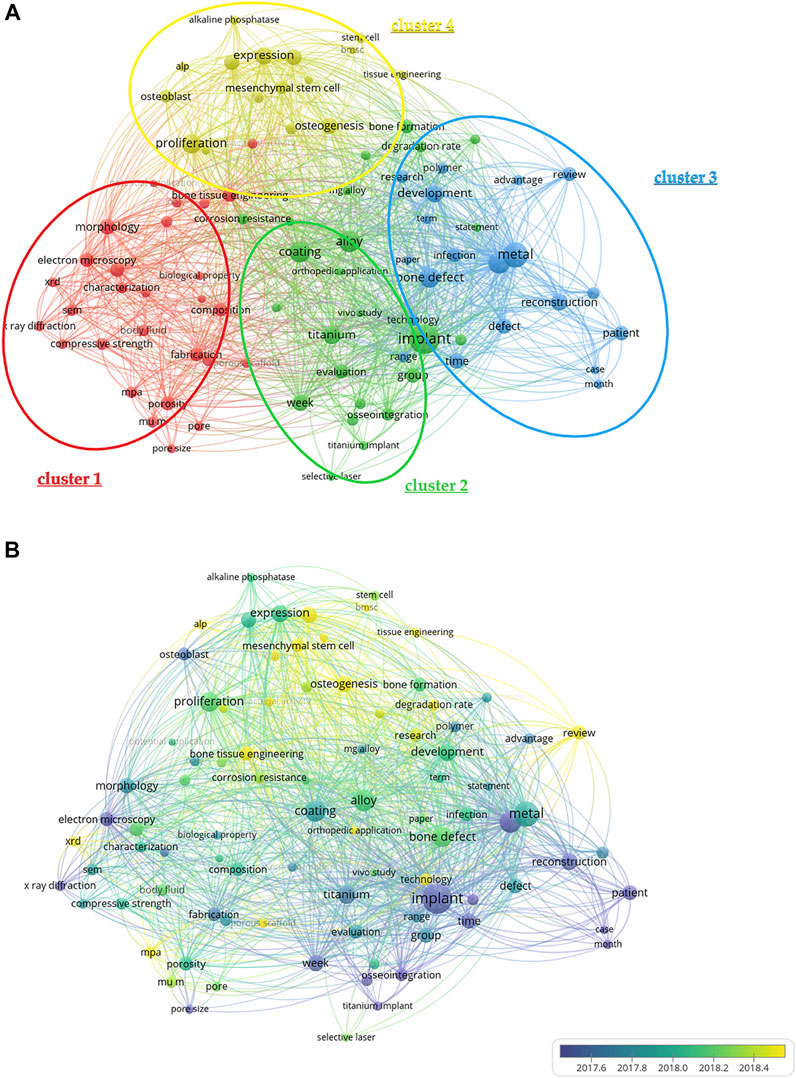
FIGURE 7. Co-occurrence analysis of all keywords in the publications on metal materials and bone repair. (A) Mapping of the keywords in the field of metal materials and bone repair. The size of the circle represents the frequency of the keyword, and different colors represent different clusters. (B) Distribution of keywords according to the average time of appearance. Blue represents an early appearance, and yellow represents a late appearance.
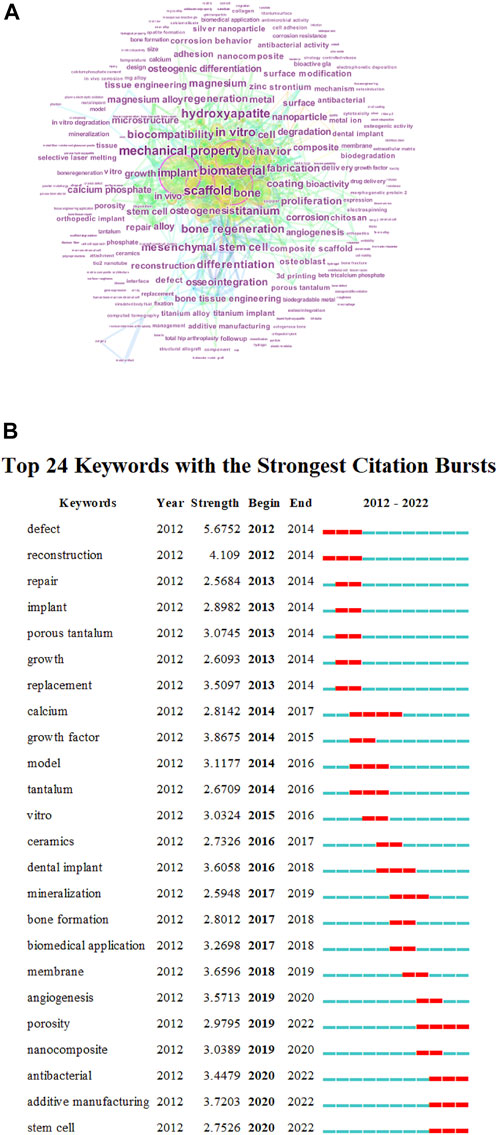
FIGURE 8. Co-occurrence analysis of all keywords using Citespace in the publications on metal materials and bone repair. (A) Mapping of the keywords in the field of metal materials and bone repair. The size of the circle represents the frequency of keywords. (B) Top 24 keywords cited most frequently from 2012 to 2022, which have received continuous attention for a period of time. The red bars represent frequently cited keywords during this time period, and the green bars represent infrequently cited keywords.
VOSviewer software divides keywords into four clusters according to the different types of the keywords, and different color clusters represent different research directions in the field. In Figure 7B, the red cluster (cluster 1) represents the structure and function of metal materials; the green cluster (cluster 2) represents metal types and surface characteristics; the blue cluster (cluster 3) represents evaluation of bone repair; and the yellow cluster (cluster 4) represents osteogenetic mechanism. As shown in Figure 7B, VOSviewer colored all keywords according to the average time of the occurrences of the keyword. Blue indicates that the word appeared relatively earlier in the past, and yellow indicates a recent appearance.
After keyword processing, the latest mentioned keyword within the cluster of the structure and function of metal materials was porous scaffold (32 times), and the average year of publication was 2019.0645. Within the cluster of metal types and surface characteristics, degradation rate (38 times) had the latest frequency of occurrences, and the average year of publication was 2018.6316. Within the cluster of evaluation of bone repair, the latest keywords were relatively older, with an average publication year earlier than 2018.5. Within the cluster of osteogenetic mechanism, the latest keywords were tissue engineering (30 times) and angiogenesis (26 times), and the average years of publication were 2018.9333 and 2019.3077, respectively. Additional details about the keywords are presented in Supplementary Table S1. Regarding the colors of the four clusters separated by VOSviewer, we can clearly observe that the current research focus in this field has shifted from metal material to osteogenetic mechanism (cluster 4) (Figure 7B), which provides guidance for future research.
Among all 87 keywords, 24 lasted for the longest time (Figure 8B). The newest salient keyword was “stem cell,” which was highlighted from 2020 to 2022; that is, for approximately 3 years. “Additive manufacturing” and “antibacterial” were also salient keywords in the current study, and they were highlighted for 3 years, but they were not as novel as stem cells. Since 2020, “stem cell” has gradually become the focus of research in this field. Similarly, “stem cell” also appeared in the latest field of research in the cluster of osteogenic mechanisms.
As shown in Figure 9, the 556 included articles were mainly divided into two fields: the first group was physics, materials, and chemistry, and the second was molecular, biology, and immunology. In addition, the references of these 556 articles were mainly distributed also in the following two fields: the first was molecular, biology, and genetics, and the second was physics, materials, and chemistry. In summary, in this study, the field of metal materials and bone repair mainly involved subdisciplines in engineering and biology.
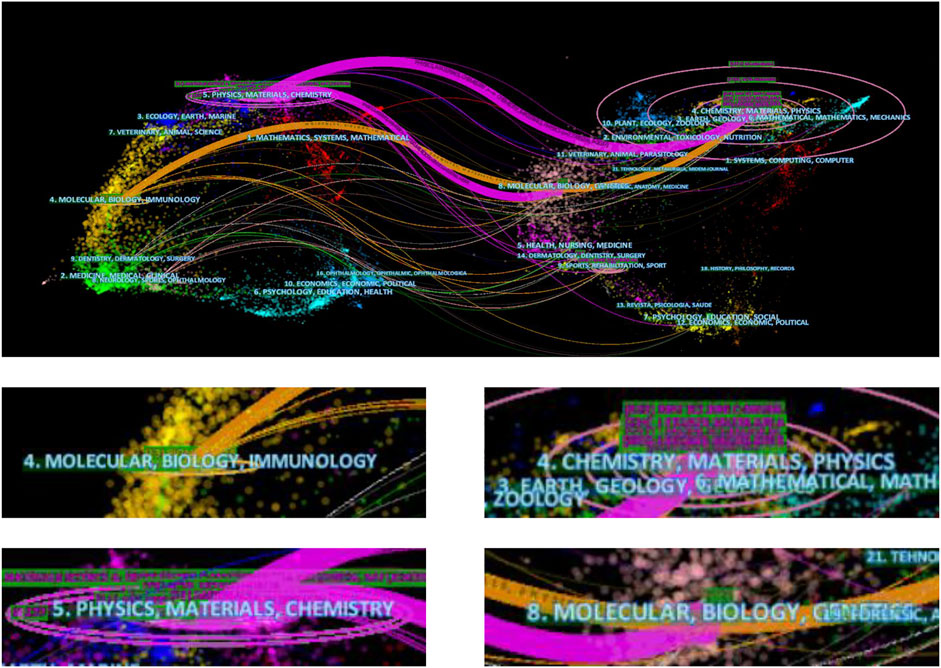
FIGURE 9. Related fields of metal materials and bone repair. The left side represents the fields of articles included in the study, and the right side represents the fields of the references of the articles.
In terms of the number of publications, China, the United States, and Germany ranked as the top three. Both the United States and China are leaders in the fields of metal materials and bone repair. Although the United States published less than half of China’s papers, it had the same performance as China in terms of the H-index and total citations. The H-index of China was 39, and the H-index of the United States was 30. The sum of citations of China was 5,771 and that of the United States was 4,413 (Figure 3A). The results suggest that China and the United States have a leading position in the field due to their dominance in economics and science.
The number of papers published in the United States has been in a relatively stable state for 10 years. In contrast, in the 4 years from 2018 to 2021, the number of papers published in China increased dramatically, with an average of 32.85 articles per year. The development of this field in China has played a significant role in driving the entire field, and the RRI value increased to six times the original value within 10 years (Figure 3B), which indicates that the development of this field generally had an upward trend, especially from 2018 to 2021.
The top institutions have played a supporting role in the country’s high volume of publications. Among the top 10 institutions in terms of publication volume, eight institutions were from China. The top three institutions (Chinese Academy of Sciences, Shanghai Jiao Tong University, and Institute of Metal Research Cas) were all from China (Figure 5B). Partnerships can often lead to advances in basic science and provide impetus for more publications to emerge. As shown in Figure 4B, the circles from China are lighter in color, which means that the publications from China are relatively recent. Although Iran only ranked sixth in the number of publications, its circle had the lightest color, which indicates that Iran has recently published many papers and exhibited a strong research interest. Interestingly, China and the Chinese Academy of Sciences have contributed most to the field, Therefore, we have reasons to believe that the in-depth research performed by these institutions supports the promotion and development of the country’s research in this field.
In terms of the journals, we found that the impact factors of the top 10 journals varied widely, ranging from 2.264 to 12.479, which also shows that the research level in this field is not the same and has substantial potential (Figure 6A). Most articles had published in Materials Science and Engineering C-Materials for Biological Applications and Acta Biomaterialia, and the journals involved the two aspects of biomedicine and materials science, which also shows that as an interdisciplinary field, its development depends on the common development of various fields.
We selected the top 10 publications with total citations in the past 3 years, and the results suggested that three were about porous polymer scaffolds. Metallic zinc and magnesium also received attention, and four were about this topic (Table 1). The topical and top-ranked article “Metal phenolic nanodressing of porous polymer scaffolds for enhanced bone regeneration via interfacial gating growth factor release and stem cell differentiation” focused on the metal-phenolic network on the pore surface of porous polylactic acid scaffolds, enabling the scaffold to achieve sustained release of load molecules, which plays a significant role in the repair of rat tibia (Zhang et al., 2022). The second-ranked article focused on the role of a novel porous scaffold synthesized by poly (lactide-co-glycolide), Mg powder, and β-tricalcium phosphate as an osteogenic material (Lai et al., 2019). The third-ranked article, “Silver nanoparticles: Synthesis, medical applications and biosafety,” introduced a new and smaller silver nanoparticle for osteogenesis (Xu et al., 2020). We found that the emergence of new materials has received more attention in the last 3 years, especially composite materials with scaffolds as the core.
In addition, in terms of research fields, subjects related to materials, such as physics, materials, and chemistry (Figure 9), are worthy of attention. In terms of the research field, the research was not limited to materials application. Basic research, such as that relating to molecular, biology, and immunology (Figure 8), cannot be ignored. The development of many fields requires multidisciplinary communication and assistance, and this is true for metal materials and bone repair.
According to the map based on the bibliographic results from the co-occurrence analysis of all keywords (Figures 7A,C), the keywords were divided into four clusters (Figure 7B). The latest keywords of the four clusters indicate the future research hotspots in this field.
With respect to the latest research hotspots, in the cluster of structure and function of metal materials, the newest keyword of this cluster was porous scaffold with an AAY of 2019.0645. With the rapid increase of research interest in bone repair, the increasing types of porous scaffolds provide ideas for the treatment of bone defects. “Hierarchically porous hydroxyapatite hybrid scaffold incorporated with reduced graphene oxide” (Zhou et al., 2019) has been proven to be capable of bone repair. In recent years, research has focused on metal materials supported by porous scaffolds, silver nanoparticle–loaded nanohydroxyapatite, and reduced graphene oxide 3D scaffolds have shown value in infected bone defect treatment (Weng et al., 2020). Research on the mechanism of osteogenesis has been carried out by TW Sun’s team. They found that porous nanocomposite with zinc-containing nanoparticles and chitosan can promote osteogenic differentiation of rat bone marrow-derived mesenchymal stem cells (Sun et al., 2018). In addition to the metal materials supported by porous scaffolds, many metal materials with high hardness are also used in the preparation of porous scaffolds. Chen’s research added magnesium powder to the production process of porous titanium scaffolds, and they successfully applied it to the field of bone tissue engineering (Chen et al., 2017). In vitro cell culture tests on the scaffold samples using human mesenchymal stem cells demonstrated their biocompatibility and indicated osseointegration potential. Therefore, in terms of the structure and function of metal materials, porous scaffolds could be a focus of future research.
In the metal types and surface characteristics cluster, degradation rate was the most recent, with an AAY of 2018.6316. With the wide application of metal materials in the field of bone defects, the physical and chemical properties of metal materials are particularly important, especially the degradation rate of metal materials. Studies have confirmed that the in vivo degradation rate of alginate–chitosan hydrogels influence tissue repair following physical injury, which was determined primarily by the in vivo degradation rate of the alginate–chitosan hydrogel. A 2020 study from the United States explains why. It is directly related to the metal element calcium ion. They found that alginate–chitosan hydrogels in different ratios with or without calcium cross-linking influence bone repair (Erickson et al., 2020). However, the latest research has led to innovation in the evaluation method of the degradation rate. A team of Chinese researchers recently made a discovery in this field using a wireless magnetoelastic sensor to monitor and assess the degradation rate of magnesium-based artificial bone in vitro. The mechanism is that a strain directly worked on the magnetoelastic-based sensor and changed the value of the relative output power. The change in the value corresponded to the change in the degradation rate (Ren et al., 2018).
Within the cluster of evaluation of bone repair, the latest keywords appeared relatively earlier in the past, with an average publication year earlier than 2018.5. Therefore, there is on keyword represented the latest research progress. However, in the cluster of osteogenic mechanism, the latest terms were tissue engineering (AAY 2018.9333) and angiogenesis (AAY 2019.3077). In this field, the emergence of a large number of recent keywords also indicates that the research in this field has received continuous attention in recent years.
In bone tissue engineering, a high concentration of osteoblasts is cultured and amplified in vitro and implanted into a scaffold that can be gradually degraded and absorbed by the human body. With the gradual degradation of biomaterials, the implanted bone cells proliferate continuously and thus repair bone tissue defects (Wubneh et al., 2018). Since Crane GM first introduced the concept of bone tissue engineering in 1995, the field has developed rapidly in the last 30 years (Crane et al., 1995). In recent years, biodegradable scaffolds fabricated from polymers have received much attention from researchers and thus helped the tissue engineering sector by providing many alternative materials whose functionality is similar to that of natural bones. The team of Anita Lett J presented the fabrication and testing of a novel composite, namely magnesium-doped hydroxyapatite glazed onto polylactic acid scaffolds where polyvinyl alcohol was used as a binder. Based on the research outcomes of biocompatibility, antibacterial activity, and mechanical resistance, the fabricated composite suits were identified as a promising biomaterial platform for bone tissue engineering. They helped the open reduction of the internal fixation of bone fractures and internal repairs (Anita Lett et al., 2021). The primary role of bone tissue engineering is to repair damaged bones and facilitate the speedy recovery of the injured bones (Betz et al., 2008), and the emergence of new metal materials has laid a foundation for the development of this field.
In the process of bone formation, stable blood supply is particularly important, as it is responsible for nutrition support, waste discharge, oxygen supply, and other functions. Rapid angiogenesis is also a basis for bone repair (Peng et al., 2020). In the field of metal materials, recent results suggest that zinc has the ability to develop blood vessels, and it has been widely used in the preparation of implants. Dexamethasone loaded on a Zn-Mg-MOF74 coating-modified polyetheretherketone implant with bacteriostasis, angiogenesis, and osteogenesis properties has great clinical application potential as a bone graft material (Xiao et al., 2021). A 2020 study explored its mechanism. It was found that zinc silicate/nanohydroxyapatite/collagen scaffolds can modulate monocytes and thereby create a favorable osteogenic microenvironment that promotes BMSC migration and differentiation and vessel formation by activating the p38 signaling pathway. Zinc plays a clear role in this process (Song et al., 2020). However, some studies have pointed out that the role of Zn in promoting angiogenesis is still unknown, and its role may be related to the material itself (Saghiri et al., 2015b). In addition to zinc, metals such as calcium, iron, and copper also have the effect of angiogenesis (Saghiri et al., 2015a), and their application in osteogenesis and mechanism of action also require more research.
Citspace software takes into account the time of appearance of keywords and the time of attention. In our research, the newest salient keyword was “stem cell,” which was highlighted from 2020 to 2022, that is, for approximately 3 years. As a composite material, the formation and growth of bone tissue is a complex process that includes molecular, cell, and biochemical metabolic changes. There was a study approximately 10 years ago suggesting that the homing of BMSCs may play an important role in the repair of bone fractures (Wang et al., 2013). Recent research has also focused on the effects of metals on stem cells. Studies have shown that the viability and osteogenic differentiation of human adipose tissue-derived mesenchymal stem cells (in growth media without osteogenic stimulation) and cell adhesion capability are higher on nanocoated surfaces that include Zn, Ag, and/or Cu metal ions (Bostancioglu et al., 2017). Similarly, a recent review described that zinc plays a critical role in BMSCs, which can be induced by zinc into differentiating into osteoblasts, chondrocytes, or adipocytes, and zinc also modulates the formation and activity of osteoclasts (Li et al., 2022). These studies provide the basis for the use of metals to promote bone repair through interaction with stem cells, which has broad prospects in the future.
Recently, more attention has been paid to osteogenetic mechanism (Figure 7C), which suggests that although new functional materials are constantly being developed, more attention should also be paid to the internal mechanism of bone formation.
China has contributed substantially to the field of metal materials and bone repair, especially in the last five years. Cooperation between countries and disciplines is crucial. According to the RRI, we predict that the total number of global publications will grow in the future. The Chinese Academy of Sciences had the most publications. In terms of journals with the most publications, Materials Science and Engineering C-Materials for Biological Applications published the most papers. The top 10 articles by citations mainly focused on porous polymer scaffolds and the metals zinc and magnesium. Importantly, the current research focus has shifted from metal materials to osteogenetic mechanisms. Porous scaffolds, degradation rate, tissue engineering, angiogenesis, and stem cells could be research hotspots in the future.
The original contributions presented in the study are included in the article/Supplementary Material, further inquiries can be directed to the corresponding author.
ZX collected and analyzed the data, wrote the manuscript, designed the study, revised the manuscript and approved the final manuscript.
The author declares that the research was conducted in the absence of any commercial or financial relationships that could be construed as a potential conflict of interest.
All claims expressed in this article are solely those of the authors and do not necessarily represent those of their affiliated organizations, or those of the publisher, the editors and the reviewers. Any product that may be evaluated in this article, or claim that may be made by its manufacturer, is not guaranteed or endorsed by the publisher.
The Supplementary Material for this article can be found online at: https://www.frontiersin.org/articles/10.3389/fmats.2022.954525/full#supplementary-material
Agarwal, A., Durairajanayagam, D., Tatagari, S., Esteves, S. C., Harlev, A., Henkel, R., et al. (2016). Bibliometrics: Tracking research impact by selecting the appropriate metrics. Asian J. Androl. 18 (2), 296. doi:10.4103/1008-682X.171582
Anita Lett, J., Sagadevan, S., Leonard, E., Fatimah, I., Motalib Hossain, M. A., Mohammad, F., et al. (2021). Bone tissue engineering potentials of 3D printed magnesium-hydroxyapatite in polylactic acid composite scaffolds. Artif. Organs 45 (12), 1501–1512. doi:10.1111/aor.14045
Bai, J., Li, L., Kou, N., Bai, Y., Zhang, Y., Lu, Y., et al. (2021). Low level laser therapy promotes bone regeneration by coupling angiogenesis and osteogenesis. Stem Cell Res. Ther. 12 (1), 432. doi:10.1186/s13287-021-02493-5
Betz, V. M., Betz, O. B., Harris, M. B., Vrahas, M. S., and Evans, C. H. (2008). Bone tissue engineering and repair by gene therapy. Front. Biosci. 13, 833. doi:10.2741/2724
Bostancioglu, R. B., Gurbuz, M., Akyurekli, A. G., Dogan, A., Koparal, A. S., Koparal, A. T., et al. (2017). Adhesion profile and differentiation capacity of human adipose tissue derived mesenchymal stem cells grown on metal ion (Zn, Ag and Cu) doped hydroxyapatite nano-coated surfaces. Colloids Surfaces B Biointerfaces 155, 415–428. doi:10.1016/j.colsurfb.2017.04.015
Chen, Y., Frith, J. E., Dehghan-Manshadi, A., Attar, H., Kent, D., Soro, N. D. M., et al. (2017). Mechanical properties and biocompatibility of porous titanium scaffolds for bone tissue engineering. J. Mech. Behav. Biomed. Mat. 75, 169–174. doi:10.1016/j.jmbbm.2017.07.015
Crane, G. M., Ishaug, S. L., and Mikos, A. G. (1995). Bone tissue engineering. Nat. Med. 1 (12), 1322–1324. doi:10.1038/nm1295-1322
Einhorn, T. A. (1995). Enhancement of fracture-healing. J. Bone Jt. Surg. 77 (6), 940–956. doi:10.2106/00004623-199506000-00016
Einhorn, T. A., and Gerstenfeld, L. C. (2015). Fracture healing: Mechanisms and interventions. Nat. Rev. Rheumatol. 11 (1), 45–54. doi:10.1038/nrrheum.2014.164
Erickson, C. B., Newsom, J. P., Fletcher, N. A., Feuer, Z. M., Yu, Y., Rodriguez-Fontan, F., et al. (2020). In vivo degradation rate of alginate-chitosan hydrogels influences tissue repair following physeal injury. J. Biomed. Mat. Res. 108 (6), 2484–2494. doi:10.1002/jbm.b.34580
Fischer, V., Haffner-Luntzer, M., Amling, M., and Ignatius, A. (2018). Calcium and vitamin D in bone fracture healing and post-traumatic bone turnover. Eur. Cell. Mat. 35, 365–385. doi:10.22203/eCM.v035a25
Hadjiargyrou, M., and O'Keefe, R. J. (2014). The convergence of fracture repair and stem cells: Interplay of genes, aging, environmental factors and disease. J. Bone Min. Res. 29 (11), 2307–2322. doi:10.1002/jbmr.2373
Horowitz, R. A., Leventis, M. D., Rohrer, M. D., and Prasad, H. S. (2014). Bone grafting: History, rationale, and selection of materials and techniques. Compend. Contin. Educ. Dent. 35 (4 Suppl), 1–6. quiz7.
Kumar, V. B., Khajuria, D. K., Karasik, D., and Gedanken, A. (2019). Silver and gold doped hydroxyapatite nanocomposites for enhanced bone regeneration. Biomed. Mat. 14 (5), 055002. doi:10.1088/1748-605X/ab28e4
Lai, Y., Li, Y., Cao, H., Long, J., Wang, X., Li, L., et al. (2019). Osteogenic magnesium incorporated into PLGA/TCP porous scaffold by 3D printing for repairing challenging bone defect. Biomaterials 197, 207–219. doi:10.1016/j.biomaterials.2019.01.013
Li, C., Wang, Q., Gu, X., Kang, Y., Zhang, Y., Hu, Y., et al. (2019). Porous Se@SiO2 nanocomposite promotes migration and osteogenic differentiation of rat bone marrow mesenchymal stem cell to accelerate bone fracture healing in a rat model. Int. J. Nanomedicine 14, 3845–3860. doi:10.2147/IJN.S202741
Li, H., Li, M., Ran, X., Cui, J., Wei, F., Yi, G., et al. (2022). The role of zinc in bone mesenchymal stem cell differentiation. Cell. Reprogr. 24 (2), 80–94. doi:10.1089/cell.2021.0137
Peng, Y., Wu, S., Li, Y., and Crane, J. L. (2020). Type H blood vessels in bone modeling and remodeling. Theranostics 10 (1), 426–436. doi:10.7150/thno.34126
Ren, L., Yu, K., and Tan, Y. (2018). Monitoring and assessing the degradation rate of magnesium-based artificial bone in vitro using a wireless magnetoelastic sensor. Sensors (Basel) 18 (9), 3066. doi:10.3390/s18093066
Roldan-Valadez, E., Salazar-Ruiz, S. Y., Ibarra-Contreras, R., and Rios, C. (2019). Current concepts on bibliometrics: A brief review about impact factor, eigenfactor score, CiteScore, SCImago journal rank, source-normalised impact per paper, H-index, and alternative metrics. Ir. J. Med. Sci. 188 (3), 939–951. doi:10.1007/s11845-018-1936-5
Saghiri, M. A., Asatourian, A., Orangi, J., Sorenson, C. M., and Sheibani, N. (2015a). Functional role of inorganic trace elements in angiogenesis--Part I: N, Fe, Se, P, Au, and Ca. Crit. Rev. Oncol. Hematol. 96 (1), 129–142. doi:10.1016/j.critrevonc.2015.05.010
Saghiri, M. A., Asatourian, A., Orangi, J., Sorenson, C. M., and Sheibani, N. (2015b). Functional role of inorganic trace elements in angiogenesis-Part II: Cr, Si, Zn, Cu, and S. Crit. Rev. Oncol. Hematol. 96 (1), 143–155. doi:10.1016/j.critrevonc.2015.05.011
Shimizu, T., Fujita, N., Tsuji-Tamura, K., Kitagawa, Y., Fujisawa, T., Tamura, M., et al. (2021). Osteocytes as main responders to low-intensity pulsed ultrasound treatment during fracture healing. Sci. Rep. 11 (1), 10298. doi:10.1038/s41598-021-89672-9
Shu, L., and Sugita, N. (2020). Analysis of fracture, force, and temperature in orthogonal elliptical vibration-assisted bone cutting. J. Mech. Behav. Biomed. Mat. 103, 103599. doi:10.1016/j.jmbbm.2019.103599
Song, Y., Wu, H., Gao, Y., Li, J., Lin, K., Liu, B., et al. (2020). Zinc silicate/nano-hydroxyapatite/collagen scaffolds promote angiogenesis and bone regeneration via the p38 MAPK pathway in activated monocytes. ACS Appl. Mat. Interfaces 12 (14), 16058–16075. doi:10.1021/acsami.0c00470
Sun, T. W., Yu, W. L., Zhu, Y. J., Chen, F., Zhang, Y. G., Jiang, Y. Y., et al. (2018). Porous nanocomposite comprising ultralong hydroxyapatite nanowires decorated with zinc-containing nanoparticles and chitosan: Synthesis and application in bone defect repair. Chem. Eur. J. 24 (35), 8809–8821. doi:10.1002/chem.201800425
Venkataraman, P., Selvakumar, K., Krishnamoorthy, G., Muthusami, S., Rameshkumar, R., Prakash, S., et al. (2010). Effect of melatonin on PCB (Aroclor 1254) induced neuronal damage and changes in Cu/Zn superoxide dismutase and glutathione peroxidase-4 mRNA expression in cerebral cortex, cerebellum and hippocampus of adult rats. Neurosci. Res. 66 (2), 189–197. doi:10.1016/j.neures.2009.10.015
Wang, X., Wang, Y., Gou, W., Lu, Q., Peng, J., Lu, S., et al. (2013). Role of mesenchymal stem cells in bone regeneration and fracture repair: A review. Int. Orthop. 37 (12), 2491–2498. doi:10.1007/s00264-013-2059-2
Weng, W., Li, X., Nie, W., Liu, H., Liu, S., Huang, J., et al. (2020). One-step preparation of an AgNP-nHA@RGO three-dimensional porous scaffold and its application in infected bone defect treatment. Int. J. Nanomedicine 15, 5027–5042. doi:10.2147/IJN.S241859
Wubneh, A., Tsekoura, E. K., Ayranci, C., and Uludag, H. (2018). Current state of fabrication technologies and materials for bone tissue engineering. Acta Biomater. 80, 1–30. doi:10.1016/j.actbio.2018.09.031
Xiao, T., Fan, L., Liu, R., Huang, X., Wang, S., Xiao, L., et al. (2021). Fabrication of dexamethasone-loaded dual-metal-organic frameworks on polyetheretherketone implants with bacteriostasis and angiogenesis properties for promoting bone regeneration. ACS Appl. Mat. Interfaces 13 (43), 50836–50850. doi:10.1021/acsami.1c18088
Xu, L., Wang, Y. Y., Huang, J., Chen, C. Y., Wang, Z. X., Xie, H., et al. (2020). Silver nanoparticles: Synthesis, medical applications and biosafety. Theranostics 10 (20), 8996–9031. doi:10.7150/thno.45413
Zhang, Y., Xu, J., Ruan, Y. C., Yu, M. K., O'Laughlin, M., Wise, H., et al. (2016). Implant-derived magnesium induces local neuronal production of CGRP to improve bone-fracture healing in rats. Nat. Med. 22 (10), 1160–1169. doi:10.1038/nm.4162
Zhang, Y., Li, K., Shen, L., Yu, L., Ding, T., Ma, B., et al. (2022). Metal phenolic nanodressing of porous polymer scaffolds for enhanced bone regeneration via interfacial gating growth factor release and stem cell differentiation. ACS Appl. Mat. Interfaces 14 (1), 268–277. doi:10.1021/acsami.1c19633
Keywords: metal materials, bone repair, angiogenesis, porous scaffold, tissue engineering
Citation: Xu Z (2022) Research trends and progress in the field of metal materials and bone repair: Comprehensive bibliometric and visual analysis (2012–2021). Front. Mater. 9:954525. doi: 10.3389/fmats.2022.954525
Received: 27 May 2022; Accepted: 14 July 2022;
Published: 10 August 2022.
Edited by:
Ramiro Ruiz Rosas, University of Malaga, SpainReviewed by:
Walter Caseri, ETH Zürich, SwitzerlandCopyright © 2022 Xu. This is an open-access article distributed under the terms of the Creative Commons Attribution License (CC BY). The use, distribution or reproduction in other forums is permitted, provided the original author(s) and the copyright owner(s) are credited and that the original publication in this journal is cited, in accordance with accepted academic practice. No use, distribution or reproduction is permitted which does not comply with these terms.
*Correspondence: Zhuoran Xu, eHpyX3N0dWR5QDE2My5jb20=
Disclaimer: All claims expressed in this article are solely those of the authors and do not necessarily represent those of their affiliated organizations, or those of the publisher, the editors and the reviewers. Any product that may be evaluated in this article or claim that may be made by its manufacturer is not guaranteed or endorsed by the publisher.
Research integrity at Frontiers

Learn more about the work of our research integrity team to safeguard the quality of each article we publish.